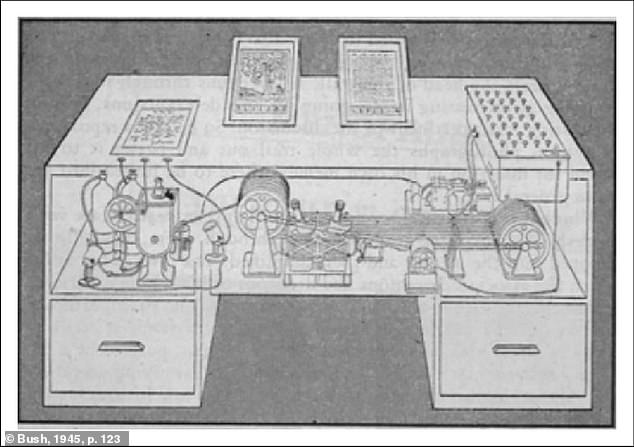[ad_1]
Today’s youngsters will never know the painstaking task of going to a library and searching for an article or a particular book.
This tedious undertaking involved hours upon hours of trawling through drawers filled with index cards – typically sorted by author, title or subject.
An explosion in research publications during the 1940s made it especially time-consuming to locate what you wanted, especially as this was before the invention of the internet.
Now, an expert has lifted the lid on the man and the device that changed everything – and it could also be the key to surviving AI.
Dr Martin Rudorfer, a lecturer in Computer Science at Aston University, said an American engineer called Vannevar Bush first came up with a solution, dubbed the ‘memex’.
‘He could see that science was being drastically slowed down by the research process, and proposed a solution that he called the “memex”,’ Dr Rudorfer wrote in an article for The Conversation.
This revolutionary invention was billed as a personal device built into a desk that could store large numbers of documents.
Some say the hypothetical design – which never quite made it to production lines – laid the foundation for the internet. Dr Rudorfer believes it could also teach us valuable lessons about AI – and how to avoid machines taking over our lives.

The design of the memex, as envisaged by Vannevar Bush. It was billed as a personal device built into a desk that could store large numbers of documents

Vannevar Bush (pictured) was an American engineer who head the U.S. Office of Scientific Research and Development (OSRD) during WWII
[The memex] would rely heavily on microfilm for data storage, a new technology at the time,’ he explained.
‘The memex would use this to store large numbers of documents in a greatly compressed format that could be projected onto translucent screens.’
At the time, microfilm was a relatively new invention and was a method of storing miniature photographic reproductions of documents and books.
One of the most important parts of the memex design was a form of indexing that would allow the user to click on a code number alongside a document and jump to a linked document or view them at the same time – without needing to sift through an index.
In an influential essay titled ‘As We May Think’, published in The Atlantic in July 1945, Mr Bush acknowledged that this kind of keyboard click-through wasn’t yet technologically feasible.
However he believed it wasn’t far off, citing existing systems for handling data such as punched cards as potential forerunners.
His idea was that a user would create connections between items as they developed their personal research library with ‘associative trails’ running through them – much like today’s Wikipedia.
‘Bush thought the memex would help researchers to think in a more natural, associative way that would be reflected in their records,’ Dr Rudorfer said.

The memex design was thought to have inspired the American inventors Ted Nelson and Douglas Engelbart, who in the 1960s independently developed hypertext systems (like this one pictured)

Vannevar Bush was a renowned inventor. Here, he is pictured working on a design called the product integraph in 1927
‘He is thought to have inspired the American inventors Ted Nelson and Douglas Engelbart, who in the 1960s independently developed hypertext systems, in which documents contained hyperlinks that could directly access other documents.
‘These became the foundation of the world wide web as we know it.’
When Mr Bush reflected on his vision in 1970, he said that in the last 25 years he had witnessed technological advances in computing that were bringing his invention closer to reality.
However he felt the crux of his vision – to enhance human reasoning and creativity – was being missed.
‘In 1945 I dreamed of machines that would think with us,’ he wrote in his book Pieces of the Action.
‘Now, I see machines that think for us – or worse, control us.’
These concerns, written down more than 50 years ago, still feel ‘strikingly relevant’ today, Dr Rudorfer said.
‘While it’s great that we do not need to search for a book by flipping through index cards in chests of drawers, we might feel more uneasy about machines doing most of the thinking for us,’ he wrote.

Today’s technological advances include ChatGPT (pictured) which could be making us ‘lazy’, Dr Rudorfer said
‘Is this technology enhancing and sharpening our skills, or is it making us lazy?’
He warned the danger is that we end up losing skills as machines continue to do them for us.
Meanwhile the younger generations may not even get the opportunity to learn them in the first place.
The memex may help save us from AI, he said, because it reminds us to try and protect our creativity and reasoning at the same time as developing technology.
[ad_2]
This article was originally published by a www.dailymail.co.uk . Read the Original article here. .


